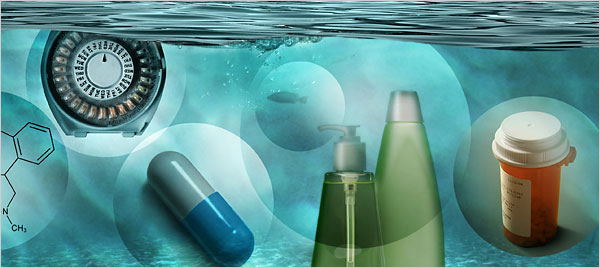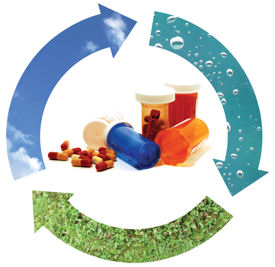
In March of 2008, the Associated Press had released information showing that 28 out of 35 US watersheds tested had detectable levels of numerous drugs. Although the detectable levels tested were in parts per billion, the astonishing finding was that there were so many different compounds. In fact, in a preceeding study conducted by the United States Geological Service in 2002, it was shown that 80% of the samples obtained from 139 streams contained numerous widely used drugs! Here are just a few of them:
17-α Ethynyl Estradiol
This is a a synthetic estrogen present in oral contraceptives and is potentially responsible for the feminization of male fish. In fact, an article in Scientific American (June, 2009) stated that “estrogen exposure reduces a fish’s ability to produce proteins that help it ward off disease and pointed to a possible link between the occurrence of intersex fish…male fish carrying immature female egg cells in their testes.”
Acetaminophen
Also known to us as Tylenol, Acetaminophen has been widely used for pain relief among other things. Surprisingly, detectable levels of this drug have been found in 24% of tested waterways.
Other Steroids and Hormones
Other steriods as well has hormones and hormone-mimicking agents such as nonylphenol were found in 16% of tested waterways. Although the effects of these hormones and hormone-mimicking agents are still largely unstudied, one has to wonder if they are also having a negative impact on the fish populations in many of our waterways.
Diltiazem
Less known to the public, diltiazem is part of a group of drugs called calcium channel blockers used for the treatment of high blood pressure, angina, and some types of heart arrhythmias. Diltiazem works as a strong vasodilator–it increases blood flow and decreases the heart rate.
Codeine
Many people have at one time or another used codeine as part of a mixed preparation with acetaminophen or in cough syrup. It is a alkaloid found in opium and is a controlled substance due to its potential for being habit-forming. Codeine has several indications for use including cough, diarrhea, pain, and IBS. Given its wide use, it is no surprise that it has been found in numerous waterways as well.
Antibiotics and Antimicrobials
This is perhaps another one of those categories of drugs that has received widespread media coverage given the increased occurence of antibiotic resistance. A variety of antibiotics including ampicillin, tetracycline, penicillin and erythromycin have been found in testable amounts in numerous waterways. Not surprisingly, wild Geese resistant to these antibiotics have been found.
Ibuprofen
Ibuprofen is a commonly used drug for the treatment of pain. It has been found in 10% of sampled waterways.
Detectable levels? So what?
Although many can argue that there is a difference between detectable and therapeutic or toxic levels, the fact remains that our waterways are being contaminated by “foreign” agents. We would be remiss to simply push this alarming fact aside and ignore the potential for slow accumulation in aquatic life. To be so bold as to say that since there have been no described human effects, there should be nothing to fear is short-sighted and foolish. Additive effects of pollutants, and the concept of increased bioconcentration as we move up the food chain have already been seen in other toxic compounds such as mercury. For example, mercury poisoning from fish is a well-described phenomenon. In fact, famous actor Jeremy Piven (Old School and Entourage) suffered from mercury poisoning following a high-fish diet that forced him to cancel working on the Broadway revival, “Speed-the-Plow.”
Ok, so we have contaminated waters. How did it happen?
As with any problem, the important question to address is how did it start in the first place. There are three main routes by which these contaminants enter our environment.
1. Excretion
As the name implies, drugs are excreted by the body in two main forms: urine and feces. Excretion of most drugs is primarily through urination, and comprises a continual low-level addition to the environment by many people.
2. Bathing
Many drugs are applied directly to the skin. These drugs are not completely absorbed, and are simply washed off during the process of bathing. Additionally, some drugs can be excreted in sweat and are also washed off during bathing. Again, this represents a continuous low-level contribution to environmental contamination.
3. Disposal
The final method of contamination is the direct disposal of drugs via toilets and trash. Although disposal is not a continuous source of contamination, it is episodic, and can be a significant source if disposed in large volumes by many people.
Now that we understand how we contaminate our waters, we should go back to the reason why this happens in the first place: mass prescriptions and improper consumption of medications. As a rising physician, I have seen countless examples of patients receiving medications such as antibiotics or pain relievers for conditions that cannot be appropriately treated through such means. Additionally, I have noticed a sense of undue dependence on the part of patients to medications that is simply astonishing. People expect medications to heal when in fact, many times they are better off without them. I am not saying in any way that people should not have access to medications, however, I do believe that the justified use of medications should be advised.
Another reason is that many people do not finish their prescriptions, or choose to buy them in large quantities. I have been guitly of this myself. A simple trip to a nearby wholesale retailer will prove my point–Tylenol is sold in large bottles in quantities exceeding 300 pills. The same goes for a variety of different drugs. If we are to minimize our waste, then we must be more responsible about consuming what we need and not running after the cheapest deal. Large drug companies should also be more aware of this phenomenon and certain actions should be taken to minimize the sale of wholesale drugs.
So what can we do to minimize the problem?
I will discuss ways to reduce our environmental impact in my next blog. Stay tuned!




